Seasonic Platinum SS-1050XP3 & SS-1200XP3 Power Supply Review
by E. Fylladitakis on September 3, 2014 6:00 PM EST- Posted in
- Cases/Cooling/PSUs
- Seasonic
- 1200W
- 80Plus Platinum
- 1050W
Seasonic Platinum SS-1200XP3 Hot Test Results
Surprisingly, even though they are both based on the exact same platform, the power quality of the Seasonic Platinum SS-1200XP3 is better than that of the less powerful 1050W model. It is not a very large difference, but it is evident. Whether this is true of all the 1200W models vs. the 1050W models is impossible to say, as there is always some small variance between individual units, but it is interesting to note nonetheless. The maximum voltage ripple that our instrumentation recorded is 40mV under maximum load, while siphoning 85.26 Amperes from the 12V line. Voltage regulation is a little better as well, at 0.71%, 0.82% and 0.95% for the 3.3V, 5V and 12V lines, respectively.
| Main Output | ||||||||
| Load (Watts) | 242.86 W | 604.83 W | 905.43 W | 1202.76 W | ||||
| Load (Percent) | 20.24% | 50.4% | 75.45% | 100.23% | ||||
| Line | Amperes | Volts | Amperes | Volts | Amperes | Volts | Amperes | Volts |
| 3.3 V | 4.26 | 3.36 | 10.66 | 3.35 | 15.99 | 3.33 | 21.31 | 3.33 |
| 5 V | 4.26 | 5.1 | 10.66 | 5.08 | 15.99 | 5.07 | 21.31 | 5.06 |
| 12 V | 17.05 | 12.13 | 42.63 | 12.08 | 63.94 | 12.06 | 85.26 | 12.01 |
| Line |
Regulation (20% to 100% load) |
Voltage Ripple (mV) | |||||
| 20% Load | 50% Load | 75% Load | 100% Load |
CL1 12V |
CL2 3.3V + 5V |
||
| 3.3V | 0.7% | 14 | 16 | 18 | 18 | 14 | 20 |
| 5V | 0.82% | 14 | 18 | 22 | 24 | 16 | 24 |
| 12V | 0.95% | 16 | 26 | 32 | 40 | 36 | 18 |
High ambient temperature has a discernible impact on the efficiency and performance of the Seasonic Platinum SS-1200XP3 as well, but not as large an impact as it did with the 1050W model. The average nominal load (20-100%) efficiency is reduced by 0.4%, with the maximum efficiency being 93.8% at 50% load. Apparently, the higher ratings of the components used to create the Platinum SS-1200XP3 are a bit more resilient to heat than those of the 1050W model.
The thermal and noise test results of the Seasonic Platinum SS-1200XP3 inside our hotbox were unsurprising, displaying similar behavior to that of the 1050W model. The cooling fan once again starts at 20% load but this time the Platinum SS-1200XP3 does not remain silent for long, as the cooling system reacts aggressively to the increasing temperatures, rapidly increasing the speed of the fan. This way the Platinum SS-1200XP3 maintains very low operating temperatures for a 1200W unit, effectively increasing its long-term reliability, but it sacrifices acoustic comfort in the process.


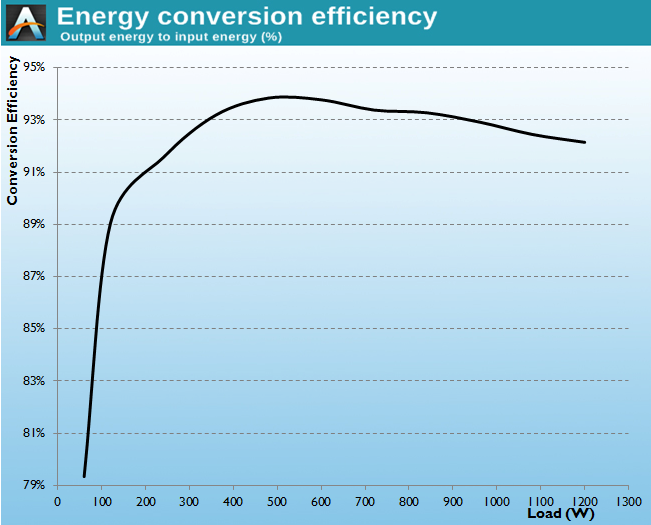
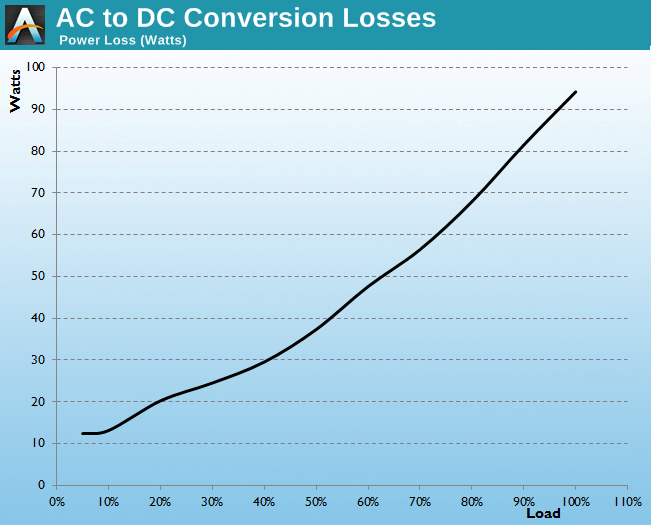
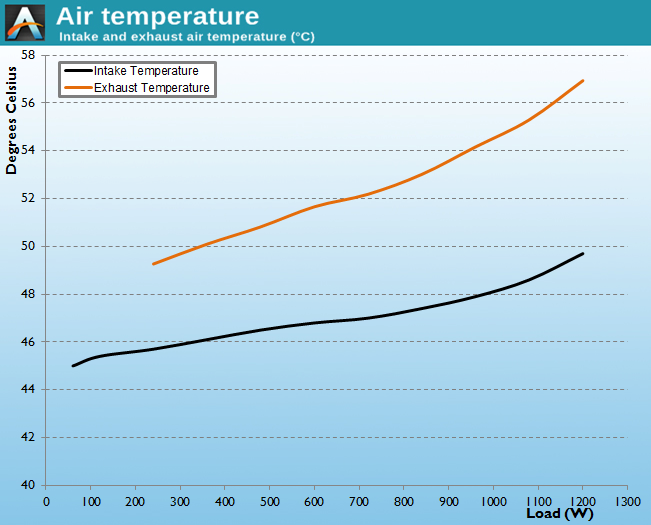
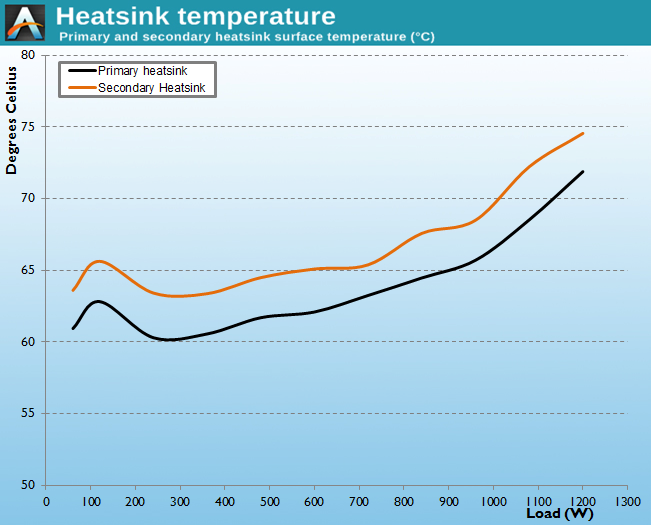
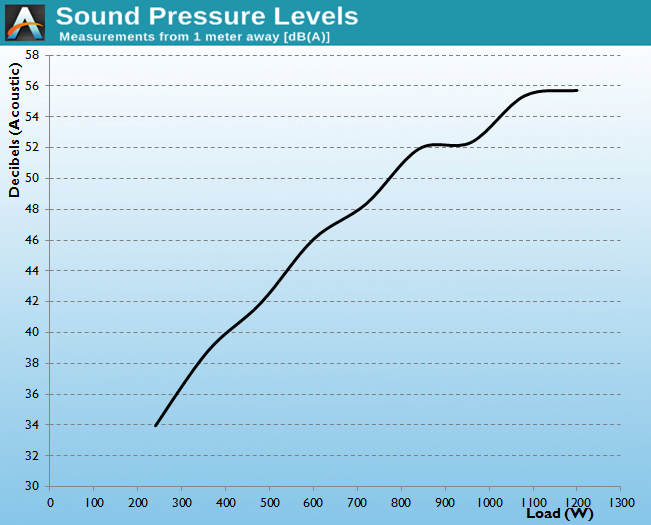








39 Comments
View All Comments
roncat - Thursday, September 4, 2014 - link
Why would you not just use a separate power supply just for the video card? Could you not just make the commons "common" for all PSU, and use the appropriate size for each application to be the most efficient. I assume the PSU outputs are fully floated. Anyone who knows why this may not work (ground loop hell, etc.), please reply.Phillip Wager - Monday, September 8, 2014 - link
this used to be an actual thing that people would do about 10 years ago when sli and crossfire just started coming out. back then everybody had full towers anyway that could house two PSUs the top one would be fore the system and drives and the bottom psu would be for your graphics card. back then 850-1000 watt power supplies were like $600 so getting two 350-500 watt power supplies was a more cost effective option. also cooler master and evga and a lot of brands made power supplies that just had 2-4 VGA eight pins coming off of it and it was marketed to gamers as video card power supplies and it was going to provide more stable power to your videocards and blah blah blah. Now the trend is to make everything SMALLER the majority of regular people who have home pcs their only home pc is actually a laptop or an all-in-one. The trend for gaming pcs is to make small game-console sized PCs and most full sized chasis these days dont even have the screw holes to fit a 2nd power supply on top of the motherboard anymore. and like i said in another post spending $70-150 to save at most 80 dollars of power over the life of the system is hardly worth the initial upfront cost especailly to deal with fitting another bulky heat source in your chasis.bebimbap - Thursday, September 4, 2014 - link
From an economical standpoint, "fixing" the lower efficiencies at almost no power draw is not worth your money. for example, and extra 15w of power 24/365 is only 131kwh most places in the us is about $.10 a kwh. why not just let it go to sleep, or shut off, most computers with ssds boot up to desktop in less than 30 seconds. But I digress, so continuing on, the inefficiency will cost you $13 more year for never using your computer. you have to subtract any time you are at non-idle state. but if you have that power supply for 8 years and not use the computer that entire time of course it adds up to $100 for keeping a computer idle 100% of the time 24/365. But if a psu was made to be 90% efficient at 10w AND 90% efficient at 1200w i guarantee you, you'd pay $200+ more per power supply for that efficiency or it'd be the size of 2 power supplies since you'd basically need 2. wasting 2x the money is also inefficient.Laststop311 - Wednesday, September 3, 2014 - link
230 is pretty expenive for the 1050 watt. I got the 80+ platinum 1000 watt seasonic for 185 45 more dollars for 50 watts is pretty crapIketh - Wednesday, September 3, 2014 - link
yea I was hoping to get a quick explanation of the differences between the 1050W and their 1000W, especially considering the price differenceIketh - Wednesday, September 3, 2014 - link
Nicely written article. The level of detail was superb.Freakie - Wednesday, September 3, 2014 - link
Dat voltage regulation though.I'm actually surprised the ripple was so high, usually Seasonic units completely beat every other unit in their class. But still, only PSU's I will put in my personal systems are Seasonic. Pretty legendary quality and performance.
SammichPG - Thursday, September 4, 2014 - link
While I understand that there's a market for this kind of unit and manifacturers send them for the halo effect, try to get some samples of low wattage units please.Most people will never go over 150-200W real world power consumption and others might be building their own nas so quality and silent power supplies in the 300W range are not only interesting but useful to a much bigger audience.
RussianSensation - Thursday, September 4, 2014 - link
Considering modern GPU's by themselves use 250-280W, and many gamers on our site use 2 of these, just in GPU power alone a solid 500W PSU is the minimum for a modern gaming rig. If all you are building is a core i3 system with no discrete GPU, then sure your system will use only 150W total.I mean really dual overclocked 780s, overclocked i7 5820K and a 1000W PSU that runs 600-700W at load keeps the system quiet.
romrunning - Thursday, September 4, 2014 - link
I think you're validating his point more than not. Today Nvidia and AMD are looking at dropping the power consumption of their GPUs, not increasing. On this site, the R9 285 was listed at 190W, and most of the R9 28x series were listed at 250W. You would have to move up to a huge card (like a Titan or R9 295x2) or dual-GPUs (SLI/Crossfire) to exceed the capabilities of a 450-550W PSU.I would say most gamers are going with the most powerful single card that they can afford, more so than dual-GPU options. Also, I think most gamers don't buy the extreme high-end, but they usually go for the one that provides the most bang-for-the-buck.
So, frankly, these reviews of high-output PSUs benefit very few. I believe more reviews of 450-550W PSUs along with looks at the power requirements of a few typical system builds a gamer might build with his own money would be more beneficial than a review of 1000W+ PSUs. Sure, do a few of them once in a while, but do more of the lower-output, more commonly-used PSUs.